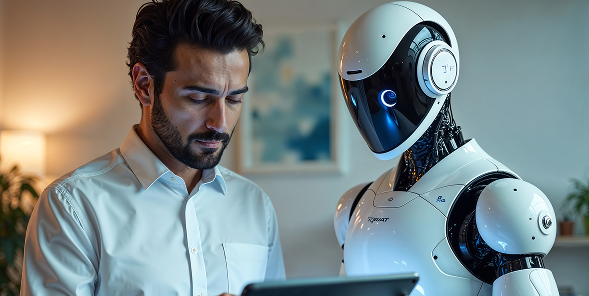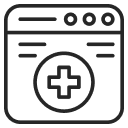Digital Product Development Process: The Complete Roadmap
- May 25, 2023
-
5578 Views
- by Ishan Vyas
Table of Contents
- What is a digital product?
- What is the product development lifecycle?
- 7 Key Stages of New Digital Product Development Process
- Most Common Models for Digital Product Development
- Benefits of New Digital Product Development Process
- How do you choose an outsourcing company for your product development?
- Best Examples of Digital Products
- Conclusion:
Nowadays, digitalization has offered people flexibility and has become a necessity for today’s generation. Business owners are looking to provide solutions by developing digital products. So, what is digital product development, and on what parameters is it built? To unravel the answers to such questions, read this blog and understand the process and lifecycle of new digital product development.
The digital product is easy to understand. Following COVID, the market has experienced a growth spurt in the development of digital products. The success rate of digital products is based on many aspects, starting with ideation, the process, business analytics, marketing strategy, customer retention, and many more.
So, are you the one interested in investing in the digital product? Well, this blog is just for you. We have curated this blog as a digital product development guide.
What is a digital product?
A digital product is any product you sell online that doesn’t have a physical form. Digital products are any services or products we obtain through software or mobile applications. The term “digital” has become widely used, opening up numerous opportunities.
The market for digital products is full of ideas and product development. Turning an idea into reality takes time. For instance, in September 2012, the Zoom application was released. However, according to Zoom’s usage statistics, Zoom generated $4.3 billion in revenue in 2021.
What is the product development lifecycle?
The product development lifecycle is the process of bringing a new product from idea to market. It covers every stage, move, and decision necessary to properly plan, build, test, and market a product.
Let’s assume you need to build a new digital product. The product lifecycle will begin with idea creation and end with the launch of the product. Several departments, including developers, designers, project managers, QA, etc., are involved in the product development cycle. Most often, there are seven stages in the development cycle of digital products. In the following section, we will go into great detail about each of the seven stages of the product development lifecycle.
7 Key Stages of New Digital Product Development Process
If you are a business owner, then you must know the development cycle. The new digital product development life cycle is distributed in a total of seven stages that initiate from idea generation to the launching of the product. Companies that create mobile apps and digital software products always have a product team in charge of creating new digital products. Let’s do a deep dive to understand the critical stages of product development.
Idea Generation:
The foremost step in your digital product development is surrounding yourself with ideas. Your idea is your vision, and that defines your product. It is the first step in building a product roadmap. The plan will determine your business goals, and user feedback will let you know the success rate.
For teams aiming to visually plan system structures in the early stages, using an architecture diagram template helps efficiently map out workflows, integrations, and infrastructure. Leveraging a ready-made template can streamline group collaboration, making sure all stakeholders are aligned from concept to deployment.
Therefore, ensure brainstorming in the early stages of idea generation to create a strong plan. The business plan must be completed in writing and include all relevant considerations and solutions.
Sometimes ideas emerge with the concept of the solution. As an example, many professional communication platforms are built to enhance productivity and help people connect directly. Such platforms are Slack, Twilio, Zoom, Skype, etc. In the market, various SaaS applications provide services that are helpful in routines.
Idea Analyzation:
The selection of the idea with the best chance of success is the focus of this stage of new product development. Provide a list of all the options available for internal review. In other words, for concept screening, look for people with relevant industry experience and expertise.
The most helpful screening will be done through a SWOT analysis. The agile development team, scrum master, product owner, and product manager go through the detailed analysis. With the SWOT analysis, you will get an idea of where advantages and strengths outweigh disadvantages and threats. As per the target audience, the product will be designed, and the product development team will undertake those tasks. Many designers use AI photo editing tools to create more attractive designs for their products.
Conclusion: To achieve better results, this step must analyze the product’s overview and state the specific New product development strategy digital product strategy to implement.
Concept Development:
The concept development facilitates comprehension of the in-depth evaluation of the product idea. A thorough rendition of the product roadmap is what is referred to as a product concept.
Understanding the user stories and the idea’s detailed version is the initial step in concept development. There are some steps in product concept development.
Evaluating Gain/Pain Ratio
Analysis of Competitors
Enlisting the Core Features
Construct a proposition chart
Evaluating the Gain/Pain Ratio:
By assessing the gain/pain ratio, you can make your business goals more clear.
Analysis of Competitors:
Conducting market research and learning about the performance of products that are similar to yours is a crucial first step. This analysis will prevent you from sacrificing the quality of your product development process.
Enlisting the Core Features:
The new product development software project’s user stories will make or ruin a company. It is crucial to understand how each of these traits is novel and how it will address a problem while compiling a list of them.
Construct a Proposition Chart:
Even if you are certain of the clarity and usefulness of an idea, it can be quite difficult to explain it to the end user in their context. The digital product’s capabilities must be made crystal clear to the end user.
Business Analysis and Market Strategy:
The stage at which the marketing department intervenes and makes plans for the marketing tasks Determining how to market the product, which promotes business expansion, is a crucial step in the development of any digital product. Also the stage for idea validation before starting to work on the digital product development process.
This stage focuses on conducting a thorough business analysis to understand the market landscape, target audience, competitive positioning, and revenue potential. It includes defining the product’s unique selling points, pricing strategy, distribution channels, and marketing approach.
The marketing department examines the plan for product development and the market case study. With the right analytics and comprehension, they plan the marketing strategies to use after the product is released. Mainly, the marketing team follows the rule of the 4Ps by McCarthy, which refers to the four fundamental elements of a marketing strategy: product, price, place, and promotion. It involves decisions related to product development, pricing, distribution, and promotional activities to meet customer needs, maximize sales, and create a competitive advantage.
Product Development:
At this stage of the digital product development process, your product is ready to be a prototype or the first run of a product. By doing this, you’ll have a tangible example of your idea that you can test in practice as opposed to merely on paper.
This small version of your idea, sometimes referred to as a prototype or minimum viable product (MVP), can help you get a feel for how it functions and identify areas that need to be improved.
Many businesses, according to Gartner, think it’s important to involve customers in the creation of products early on. This gives them a better chance to develop a product while following ergonomic standards. At this point, revenue has significantly increased due to R&D and operations costs. The R&D department will create and test one or more physical examples of the proposed product.
Launching and Testing:
You can introduce your digital product to the market once the prototype is complete. When you distribute prototypes to the target market and solicit their input on how effectively the product functions, you are conducting marketing research. It entails finding out what your target market likes about your proposed product and what they would want to see changed or added to it.
There are two different approaches to market research:
Alpha testing entails performance analysis by test engineers. They monitor the impact of the marketing mix on the finished product. Before receiving the final approval, any problems are prepared for and fixed.
Beta testing initiates user testing and provides feedback to the business. It entails paying close attention to the customer’s voice. The project team is made aware of any problems so they can be fixed.
Commercialization:
The final stage of digital product development is commercialization when your products are released to the market. During this stage, the organization will need to build or hire a production facility, which will cost the most money. A considerable sum of money may be spent on advertising, product promotion, and other marketing activities.
Here are some points to consider after your digital product is on the market:
- Determine the size of the worldwide market for your product, and then introduce the right amount of it based on that calculation.
- Create the appropriate commercials and adhere to a successful marketing strategy.
- Make sure to use digital channels in your marketing plan.
- Get your customers ready for the debut of a new product.
- Pick a time and place for your product’s launch.
- Watch your product closely and pay attention to how it performs.
- Always note the user feedback and keep continuous improvement without sacrificing quality.
Most Common Models for Digital Product Development
To maintain the workflow, development models are picked for the product development phase of the development process. For instance, many companies choose certain product development models. There are three common models for digital product development that take care of the whole process.
- Waterfall Development
- Agile Development
- Lean Development
Waterfall Development:
The fundamental model for such digital product developments or web app development processes is the waterfall methodology. This process covers the project’s workflow sequentially and logically.
To facilitate workflow, the process is broken down into stages. Since it only functions with a linear approach, you must finish each step before moving on to the next. Only the pre-defined project can benefit from this methodology; there are no feature updates allowed.
The linear path of the waterfall method is
- Idea requirement
- Analyzation
- Design and Development
- Quality Analysis
- Deployment
- Support & Maintenance
Agile Development:
Agile methodology is the most widely used and favored technique among developers. Adopting agile prioritizes customer satisfaction over excessive documentation and rigid processes. The transparent and prompt communication between developers, clients, and users is a strength of the agile methodology.
The following steps make up the agile development workflow:
- Planning & Analyzing
- Designing
- Development
- Deployment
- Testing and Review
- Launch
Lean Development:
The main goals of lean development are to increase productivity and quality. The side clusters serve to narrow the emphasis on the primary prior activities by decreasing. By prioritizing the tasks, the lean principles enable waste to be found and the process to be restructured.
This procedure aids the development team in increasing productivity, concentrating on completing important tasks, and striving for excellence.
The path of lean development is as follows:
- Product concept
- Analyze & Validate
- Development & Deployment
- Feedback
Benefits of New Digital Product Development Process
After noticing the digital market across the world, it is much more beneficial for any organization to build a digital product. To preserve your competitive advantage, your business must strike a balance between the necessity and challenges of digital product creation. It helps you decide whether your digital product will be commercially successful and economically useful.
Here are some ways that may assist you in better growth and continuous integration of your digital product development process:
- Innovative Concept
- Development Accuracy
- Saves money & Resource upgradation
- User-Centric Approach
- Continuous Improvement and Iteration
Innovative Concept:
By implementing a structured and efficient digital product development process, organizations can foster innovation and create new products that address market needs. This helps them stay competitive in a rapidly evolving digital landscape and differentiate themselves from competitors.
Development speed:
A well-defined product development process enables faster time-to-market. It streamlines workflows, eliminates bottlenecks, and allows for efficient alliances among other teams involved in the development process. As a result, companies can launch their digital products more quickly, gaining a first-mover advantage in the market.
Saves money and improves resource utilization:
An optimized development process helps with resource allocation and cost control. By identifying and addressing potential risks, challenges, and inefficiencies early in the process, organizations can minimize costly rework and delays. This leads to improved cost-effectiveness and optimized resource utilization.
User-centric Approach:
The digital product development process emphasizes understanding user needs and preferences. It incorporates user feedback, usability testing, and iterative design and development cycles.
Continuous Improvement and Iteration:
The product development process encourages an iterative and continuous improvement culture. This iterative approach allows for ongoing optimization, feature additions, and the ability to respond to market dynamics effectively.
How do you choose an outsourcing company for your product development?
How to make your digital product a reality after having the idea is the crucial question that arises. There are numerous solutions to this problem, but the most reliable one is to hire an outsourcing company to develop your product.
In the industry, many outsourcing companies provide digital development services. We at Citrusbug Technolabs, an outsourcing company, offer you the top 1% of the talent pool of software engineers to work on your digital product development. We are the one-stop solution to turning your ideas into reality. Starting from discussing the idea to creating and launching your digital product, our team will assist you.
Here are the steps that will help you choose a reliable outsourcing company:
- Define your requirements
- Evaluate the list of Outsourcing companies
- Check the case studies and portfolios
- Cross-check their expertise
- Interview the developers
- Ask for security policies
- Negotiate as per market value
- Sign the contract.
The most economical choice will be to choose an outsourcing firm from an Asian nation like India, the Philippines, Indonesia, or Vietnam. In the IT industry, India has the most experienced and largest workforce.
Best Examples of Digital Products
The following are some examples of digital products that are divided into various types, each with a brief description:
1. Software as a Service (SaaS):
Applications or software that offer services and are available on the web on a subscription basis are called SaaS applications. For example, the marketing automation platform HubSpot and Salesforce, the customer relationship management platform.
2. Mobile Applications (Apps):
Mobile applications, or software designed for smartphones and tablets, provide various concepts and services. Giving examples like Instagram (photo sharing) and Uber (ride-hailing).
3. E-commerce Platforms:
Products can be bought and sold online through websites like Etsy, which sells handmade and vintage goods, and Amazon, an online marketplace.
4. Digital Content:
Digital media like Netflix (video streaming) and Kindle (books) are used for entertainment or information. Also, services provide access to digital content or features through recurring payments, such as Spotify (music streaming) and The New York Times (online news articles).
5. Online Learning Platforms:
Websites or apps that provide educational courses, such as Khan Academy (which provides educational videos and exercises) and Coursera (which offers online courses from universities),
6. Digital Tools and Software:
Applications or tools that aid in productivity, creativity, or specific tasks, like Adobe Photoshop (image editing) and Trello (project management),
7. Internet of Things (IoT) Devices:
Physical devices connected to the internet, such as smart thermostats (e.g., Nest) and fitness trackers (e.g., Fitbit).
8. Virtual Reality (VR) and Augmented Reality (AR) Products:
Immersive experiences or overlays that blend the digital and physical worlds, like the Oculus Rift (VR headset) and Pokémon GO (AR mobile game).
9. Digital Services:
Online services provided remotely include telemedicine platforms (e.g., Teladoc) and Upwork, – a freelance marketplace.
These are just a few examples of the different types of digital products available today, which serve a variety of markets and objectives.
Conclusion:
Identifying customer satisfaction with your digital product is the primary goal of all seven stages. Following this, we cannot consider a product’s success until it does not satisfy users. The product owner needs to be aware of the seven stages of the product development process given the market’s frequent changes as a result of technology development and modernization. This article has given you a better understanding of how new product development is done. The process of developing a digital product is made simpler and less complicated by adhering to these steps.





 SaaS Development
SaaS Development Web Application Development
Web Application Development Mobile Application Development
Mobile Application Development Custom Software Development
Custom Software Development Cloud Development
Cloud Development DevOps Development
DevOps Development MVP Development
MVP Development Digital Product Development
Digital Product Development Hire Chatbot Developers
Hire Chatbot Developers Hire Python Developers
Hire Python Developers Hire Django Developers
Hire Django Developers Hire ReactJS Developers
Hire ReactJS Developers Hire AngularJS Developers
Hire AngularJS Developers Hire VueJS Developers
Hire VueJS Developers Hire Full Stack Developers
Hire Full Stack Developers Hire Back End Developers
Hire Back End Developers Hire Front End Developers
Hire Front End Developers AI Healthcare Software Development & Consulting
AI Healthcare Software Development & Consulting Healthcare App Development
Healthcare App Development EHR Software Development
EHR Software Development Healthcare AI Chatbot Development
Healthcare AI Chatbot Development Telemedicine App Development Company
Telemedicine App Development Company Medical Billing Software Development
Medical Billing Software Development Fitness App Development
Fitness App Development RPM Software Development
RPM Software Development Medicine Delivery App Development
Medicine Delivery App Development Medical Device Software Development
Medical Device Software Development Patient Engagement Software Solutions
Patient Engagement Software Solutions Mental Health App Development
Mental Health App Development Healthcare IT Consulting
Healthcare IT Consulting Healthcare CRM Software Development
Healthcare CRM Software Development Healthcare IT Managed Services
Healthcare IT Managed Services Healthcare Software Testing services
Healthcare Software Testing services Medical Practice Management Software
Medical Practice Management Software Outsourcing Healthcare IT Services
Outsourcing Healthcare IT Services IoT Solutions for Healthcare
IoT Solutions for Healthcare Medical Image Analysis Software Development Services
Medical Image Analysis Software Development Services Lending Software Development Services
Lending Software Development Services Payment Gateway Software Development
Payment Gateway Software Development Accounting Software Development
Accounting Software Development AI-Driven Banking App Development
AI-Driven Banking App Development Insurance Software Development
Insurance Software Development Finance Software Development
Finance Software Development Loan Management Software Development
Loan Management Software Development Decentralized Finance Development Services
Decentralized Finance Development Services eWallet App Development
eWallet App Development Payment App Development
Payment App Development Money Transfer App Development
Money Transfer App Development Mortgage Software Development
Mortgage Software Development Insurance Fraud Detection Software Development
Insurance Fraud Detection Software Development Wealth Management Software Development
Wealth Management Software Development Cryptocurrency Exchange Platform Development
Cryptocurrency Exchange Platform Development Neobank App Development
Neobank App Development Stock Trading App Development
Stock Trading App Development AML software Development
AML software Development Web3 Wallet Development
Web3 Wallet Development Robo-Advisor App Development
Robo-Advisor App Development Supply Chain Management Software Development
Supply Chain Management Software Development Fleet Management Software Development
Fleet Management Software Development Warehouse Management Software Development
Warehouse Management Software Development LMS Development
LMS Development Education App Development
Education App Development Inventory Management Software Development
Inventory Management Software Development Property Management Software Development
Property Management Software Development Real Estate CRM Software Development
Real Estate CRM Software Development Real Estate Document Management Software
Real Estate Document Management Software Construction App Development
Construction App Development Construction ERP Software Development
Construction ERP Software Development










